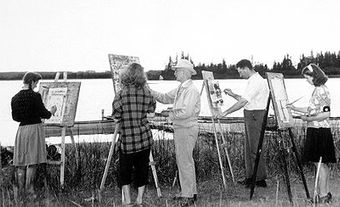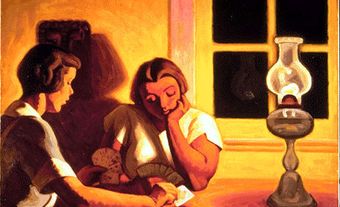Contemporary Arts Society
The Contemporary Arts Society (Société d'art contemporain) was formed January of 1939 to promote public awareness of modern art in Montréal. Membership was open to all artists of "non-academic tendencies," and the initial 25 members included Paul-Émile BORDUAS, Fritz BRANDTNER, Stanley COSGROVE, Louis MUHLSTOCK, Goodridge ROBERTS, Jori Smith and Philip SURREY. John LYMAN, a prominent Montréal painter and critic, was the society's founder and first president. In May 1939 the CAS began to admit nonartist associate members, many of whom were francophone art teachers, critics and collectors. This transformation from an essentially anglophone group continued in 1943, when Alfred PELLAN and Borduas were allowed to bring their young followers into the society as exhibiting but nonvoting junior artists. These new members included Marcel BARBEAU, Léon Bellefleur, Pierre GAUVREAU, Fernand LEDUC and Jean Paul RIOPELLE.
Lyman did not conceive of the CAS as an exhibiting organization, but many members realized that by banding together it would be easier to get exhibition space and to lobby for attention at the conservative Art Association of Montreal (now the Musée des beaux-arts de Montréal). In May 1939 the Society sponsored "Art of Our Day," a survey of modern European art in Montréal collections. In December it held the first annual members' show at a commercial gallery in the city, though many subsequent shows were hung in the Art Association itself. Most of the early anglophone members of the CAS could be broadly described as French-influenced post-impressionists. Roberts was one of the most respected painters within this group, but as Borduas and Pellan rose to prominence in the early 1940s, the society's exhibitions were increasingly dominated by abstraction. Borduas's personal influence also grew steadily, to the vexation of some conservative anglophone members and Pellan's circle of admirers.
Although the CAS was a dynamic and forward-looking artists' organization in Canada during the 1940s, it received little attention outside of Montréal. Jack HUMPHREY and Miller BRITTAIN from Saint John were the only non-Québec artists to join. The National Gallery of Canada, which played an important role in promoting the GROUP OF SEVEN, gave it no support.
By 1945 the CAS included virtually every innovative and ambitious painter in Montréal. The size, diversity and growing divisions within the society made it increasingly difficult to govern or direct. In an effort to save the organization in 1948, Borduas was elected president, but he was met by a storm of protest from members who considered him too radical (he was circulating draft copies of REFUS GLOBAL at the time). Sensing he would be unable to govern, Borduas resigned from the presidency and the CAS the day after his election. Shortly thereafter, Pellan and several of his supporters left. Lyman's coalition of artists must be considered a success; many artists found mutual support and encouragement in the society, and through its lectures, exhibitions and lobbying, it greatly increased public awareness of modern art in Montréal.
See alsoPAINTING.

 Share on Facebook
Share on Facebook Share on X
Share on X Share by Email
Share by Email Share on Google Classroom
Share on Google Classroom





